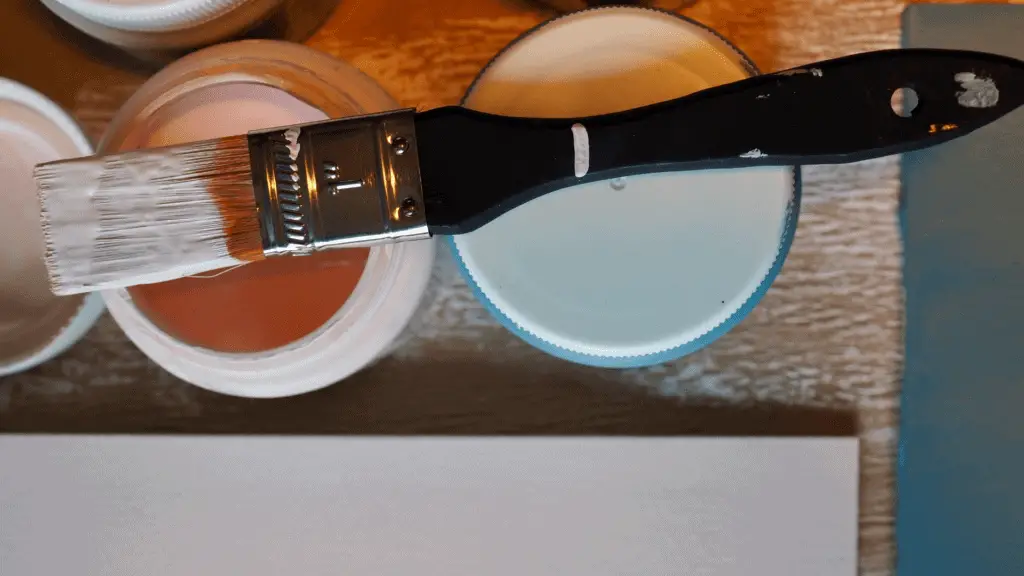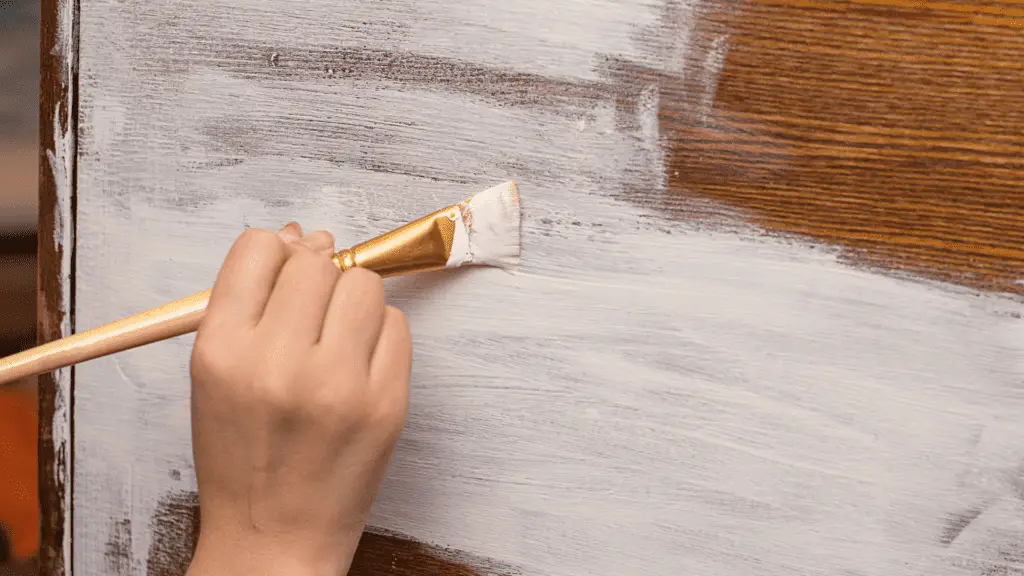Paint is oftentimes confusing. There are water-based paint, oil-based paints, and chemical-based paints. Then there are paints like acrylic, enamel, and lacquer. In this article, we will be looking at a comparison between acrylic paint and water-based paint.
Almost all acrylic paints are water-based and soluble in water. However, all water-based paints are not acrylic paint. There are other water-based paints such as watercolor, latex, gouache, tempera, and poster paints. enamel, oil paint, and lacquers are solvent-based paints.
Knowing the paint you are going to use for a paint project will yield better results. Below you will learn about an introduction to acrylic paint and water-based paint as well as a comparison between them.
What are acrylic paint and water-based paint?

Paints are simply a combination of pigment (color), binder, vehicle, and other additives. Differences in each of these components make different paints.
Acrylic paint is distinguished by the binder used. It is essentially an acrylic polymer. Acrylic polymer helps to bind the pigments together in a paint film and to adhere the paint to the surface.
A vehicle is a liquid that keeps the paint in the container fluid. It can be a solvent like water or a chemical. According to the vehicle of paint, there are two types of paint. They are water-based paint and solvent-based paint.
Is acrylic paint the same as water-based paint?
Acrylic paint is the same as water-based paint but its acrylic polymer adds different qualities to paint. Although acrylic paint is water-based, all water-based paints are not acrylic paint. Latex, watercolor, gouache, tempera, and poster paints are water-based paints besides acrylic paint.
Following are some examples of water-based paints including water-based acrylic paints.
- Aqua Lock Plus 100% Acrylic Water-Based Sealer Primer
- Rust-Oleum Painter’s Touch Latex Paint
- Liquitex Professional Heavy Body Acrylic Paints
- Majic Paints Diamond Hard Acrylic Enamel
- INSL-X Sure Step Acrylic Anti-Slip Coating Paint
- JetCoat Farm Pride Acrylic Outdoor Fence and Barn Paint
- Ocean Blue Semi-Gloss Acrylic Exterior Paint
- KILZ 1-Part Epoxy Acrylic Concrete and Garage Floor Paint
- Majic Paints Latex Flat Barn & Fence Paint
Either artist or house acrylic paints have the highest concentration of acrylic polymer compared to similar paints such as latex. This makes acrylics best for different purposes.
Acrylic paint is best for beginner to professional artists as a non-toxic fast drying art medium to paint on canvas. Acrylic house paint offers better cleanability, durability, and flexibility to the paint film, making it the best for outdoor and indoor surfaces prone to dirt, moisture, cracking, and peeling.
If you are interested to know more about acrylic house paints and their pros and cons you can read the following article: Pros and cons of acrylic house paint (and how to choose)
Solvent-based acrylic paint
As I said before, most of the acrylic paints available today are water-based. However, there are solvent-based acrylics as well. Some examples are acrylic primers, acrylic lacquer, and acrylic clear coatings. Your paint tin or the website of the brand will have paint composition information.
From there you can find many aspects of painting. Following are some examples of solvent-based acrylic paints. So that you will have a better understanding of solvent-based acrylic paints.
- Rust-Oleum Automotive Acrylic Lacquer Spray
- RUST-OLEUM Quart Universal Bonding Primer
Acrylic paint vs. waterbased paint
The main difference between acrylic and water-based paint is the concentration of acrylic polymer. Other water-based paints have less concentration of acrylic polymer binder or have a different binder such as gum arabic, polyvinyl acetate (PVA), or another chemical compound.
I have written several articles comparing acrylic paint with other water-based paints. They are as follows: Acrylic paint vs watercolors, acrylic paint vs, gouache, acrylic paint vs. poster paints, acrylic paint vs tempera paint, acrylic paint vs. fabric paint and chalk paint vs acrylic paint. In these articles, you will find a more detailed comparison.
I have also written a detailed comparison between alcohol inks and acrylic inks. You will find the unique uses of both inks and my experience with them in that article.
Below I have included a table that compares water-based paint and acrylic paint. Although acrylic paint is also water-based paint, here I will compare acrylic paint with all other water-based paint.

| Aspect | Waterbased paint | Acrylic paint |
| Binders | Has a lower acrylic polymer resin or different polymer or a binder (e.g. latex- PVA, watercolor- gum arabic) | Has the highest acrylic polymer resin |
| Usage | Used by artists to scan and reproduce or display, used as interior house paint | Used by artists for displaying purposes, used as exterior house paint |
| Coverage | Better coverage per coat or layer (house paint), artist waterbased paints can be transparent or opaque | Less coverage per coat (house paint), artist-grade acrylics have the best coverage |
| Drying qualities | Dries quickly within 30 minutes | Dries quickly within 30 minutes |
| Finishing | Less streaky | Can be streaky |
| Durability | Not very durable and weather resistant, susceptible to cracking, peeling, and blisters, ideal for indoor painting, may not be UV resistant, less resistance to wear and tear | Highly durable and weather-resistant, resistant to cracking and peeling, ideal for exterior painting, UV resistant, resist wear and tear |
| Application | Smooth application | Thicker application |
| Paint thinning | Can be thinned with water | Can be thinned with water or mineral spirit |
| Painting surface | Artists’ waterbased paint can be painted on paper, latex paints are used on walls and on wood | Can be painted on many surfaces from canvas to walls to glass to metal |
| Price | Cheap due to less acrylic polymer content | Expensive due to high acrylic polymer content |
| Accessibility | Can be found in every home improvement store | Relatively difficult to find |
Now you might wonder, which is better acrylic or water-based paint?
The best paint type depends on the type of paint project. Artist acrylic paint is best for painting on canvases with ease. Artist water-based paints are best for painting on paper with different effects. Water-based house paint like latex is best for indoor painting white acrylic paint is heavy-duty.
Now let’s get to know the differences between acrylic paint and other water-based paints in detail.
Note: Every painting is different from each other, especially in the case of house paints. The best way to know specific details related to a product will be by checking the paint technical datasheet which can be found on the paint product page on the brand website. Following is information on some general aspects when it comes to water-based paint or acrylic paint.
I have written a whole article about distinguishing acrylic paintings from other paintings. You will find many tips and tricks to know if a painting is acrylic or oil in that article.
Binders
In general, water-based paints like latex have polyvinyl acetate (PVA) as the main binder and some acrylic polymer as well. Acrylic paints have 100% acrylic polymer or a higher percentage of acrylic polymer.
The properties of the paint change according to the binder of the paint. When there is more acrylic polymer binder in the paint, the paint can stand more abrasion and resist moisture and other environmental distress. When there is a PVA polymer binder the cheaper the paint will be.
Acrylic polymer is not water-soluble and it is essentially plastic. It dries into a permanent water-resistant plastic paint layer quickly. There is solvent-based acrylic paint like lacquers and enamels as well. They also use acrylic polymer as the binder.
When it comes to artist paints, watercolor, tempera, and poster colors have a water-soluble binder called gum arabic. Since the binder is water-soluble the paint can also be reactivated with water after drying.
Usage
Water-based house paints like latex paints are generally called emulsion paints. They are mainly used to coat the interior surface of the house where the surface is mostly dry and does not have any environmental factors disturbing the paint.
Artist-grade water-based paints like watercolor are used for displaying purposes, usually by framing the artwork. Other artists’ water-based paints like gouache are used to make designs, scan, and reproduce the artwork. It is most popular when digital art was not popular. Tempera and poster paints are used in school projects by children. These paints are not permanent.

100% acrylic paints are used on exterior surfaces where weather, sunlight, and moisture disturb the paint layer. Because acrylic paint is flexible and breathable, acrylic paint can withstand most of these environmental factors. Since the paint is water-soluble, it is more convenient to use acrylic paint to have benefits as same as solvent-based paints.
Coverage
In general, water-based house paints like latex has better coverage. As an example, Rust-Oleum Painter’s Touch Latex Paint with acrylic polymer has a coverage of 11 square meters per liter of paint. Aqua Lock Plus 100% Acrylic Water-Based Sealer Primer covers 7.5 – 9 square meters per liter.
When compared to solvent-based acrylic paints such as RUST-OLEUM Quart Universal Bonding Primer only covers 1 square meter per liter of paint. So acrylic paint that is solvent-based has significantly less coverage compared to water-based acrylic paint or latex paint.
Artist water-based paints like gouache and poster paints have the best coverage. But watercolor paints are used for their transparent properties and do not cover them. Artist-grade acrylics offer the best coverage as craft or student-grade acrylic offers less coverage and is mostly transparent due to less pigment concentration with more fillers.
Drying qualities
Both acrylic and water-based paints dry faster than oil or chemical-based paints. As an example, Rust-Oleum Painter’s Touch Latex Paint is dry to touch within 30 minutes. Aqua Lock Plus 100% Acrylic Water-Based Sealer Primer dries to touch within 30 minutes and can be top-coated in an hour.
RUSRUST-OLEUM Quart Universal Bonding Primer dries to touch within 30 minutes and is ready to topcoat in an hour. Now you can see any acrylic house paints whether it is water-based or solvent paint, dries quickly within 30 minutes. Other water-based house paints like latex also dry quickly within 30 minutes.
When it comes to artist acrylic or water-based paints, they dry quickly due to being water-based. Artist acrylic paint dries within 10 to 20 minutes. Other water-based paints like watercolor, gouache, tempera, and poster colors also dry quickly within 20 minutes. You can even speed up drying with a hair drier, especially in the case of watercolor.
Finishing
You can obtain house paints in almost every finishing. There are flat, satin, gloss, semi-gloss, eggshell, and matte finishing. This is indicated on the paint tin or jar. Most shiny finishing paints have acrylic polymer in them. Acrylics provide those sheens. It helps better clean up the painted surface while giving a professional finishing.
The one little caveat with acrylic painting is that they can have streaks while painting especially those solvent-based acrylics. But other water-based paints like artist water-based paints or latex house paints are less streaky.
Artists’ acrylic paints naturally have a statin finish. But it can be changed by mixing with acrylic mediums. Other artists’ water-based paints such as watercolor, gouache, tempera, and poster colors have a matte finishing. It cannot be changed.
Durability
Water-based house paints like latex have less durability compared to acrylic paint. It is prone to cracking, peeling, and blistering, and is not resistant to moisture. Latex paint is more durable when in no contact with these environmental factors, such as moisture and UV rays. Acrylic paints are durable. It can withstand moisture, and UV rays, resistant to cracking, peeling, and blistering.
Acrylic polymer binder or plastic in acrylic paint provides flexibility and breathability to the paint film. It can contract or stretch easily without breaking the paint film. Acrylic is water-resistant after drying. It also does not fade when exposed to UV rays.
Artist acrylic has the same properties as house acrylic paints. Artist acrylic paints are highly pigmented and durable. Other water-based paints such as gouache are prone to cracking if you apply them in thick coats. You are safe as long as you apply thin paint layers of water-based paints.
Application
Water-based house paints like latex are flowier and have a smooth paint application. Acrylic house paints are thicker and have a less smooth application. Artist acrylics are thicker but can be applied smoothly by mixing with some water. Water-based artist paints also have a smooth application.

Artist acrylic paint application can be changed by mixing with water and acrylic mediums such as matte medium, gloss medium, and gel medium. But other water-based paints can only be mixed with water mainly.
Paint thinning
Water-based and acrylic paints can be thinned with water. But solvent-based acrylic paints need mineral spirits to thin the paint. Since almost all acrylic paints are water-based, cleanup and thinning can be done with water. But oil-based or solvent-based paints can only be thinned and cleaned up with mineral spirits. It is one of the caveats of using oil-based paint.
Artist acrylic paints can also be thinned with acrylic mediums other than water. Acrylic mediums contain the same acrylic polymer binder. It helps to keep the properties of acrylic paint rather than thinning with water.
Painting surface
Acrylic painting can be done on any surface as acrylic paint can stick to almost anything. You can paint walls, paper, canvas, plastic glass, and metal with acrylics. But other water-based paints can be used on limited surfaces. Artist water-based paint can be used on paper and cardboard.
Water-based house paints can be used on drywall and wood. Oil or solvent-based paints also can be painted on any surface just like acrylic paint. But as mentioned before you will have to deal with mineral spirits and the high VOC content of oil paints.
I have written a whole article about using house paint instead of artist acrylic paint in the artwork. You will find a comprehensive answer on how to use house paint, caveats of using house paint, and when it is best to use house paint in that article.
Price
Water-based house paint like latex paints is less expensive compared to acrylic paint. The more acrylic polymer in a paint, the more expensive it will be. Majic Paints Latex Flat Barn & Fence Paint(latex-waterbased) costs $0.22 / Fl Oz. INSL-X Sure Step Acrylic Anti-Slip Coating Paint(acrylic- waterbased) costs $0.38 / Fl Oz, Semi-Gloss Acrylic Exterior Paint cost $2.15 / Fl Oz. As you can see, acrylic house paints are expensive compared to latex or water-based house paint.
However when it comes to artist acrylic paint, the higher the quality (artist-grade acrylic) the more expensive they are. The lower the quality of acrylic (student or craft quality) the less expensive they are. High-quality or artist-grade acrylics offer the best color expression in a painting. Golden Heavy Body Acrylic (artist-grade water-based acrylic) cost $5.91 / Fl Oz.
However high-quality water-based paints are very expensive like $35.39/Fl Oz. But you can get them for $2/Fl Oz as well. As you can see, artist-grade acrylic and water-based have a wide price spectrum you can choose from.
Accessibility
Water-based house paint like latex can be bought in any home improvement store. But acrylic paints are relatively harder to find. Artists’ acrylic or water-based paints are also available in art stores. The high-quality ones may be difficult to find. However, you can always order the paints from a specialty online store.
The best place to buy house paint will be Home Depot. You can also order from them online from the following link: Home Depot. It is always convenient to order artist paints online. You can find the best deals at Blick Art Materials online. Following is the link to their website: Blick Art Materials

Conclusion
Most acrylic paints that are available today are water-based. When compared to other water-based paint, the difference comes from the binder in the paint. Acrylic paint has a very durable and water-resistant acrylic polymer or plastic as the binder. Other water-based paints have less durable and non-water-resistant binders such as PVA and gum arabic.
Acrylic paint is best for places such as exterior house surfaces that have exposure to moisture, abrasions, UV light, and dirt. As they are expensive using them for exterior surfaces will be the best. Water-based paints like latex are best for interior surfaces. The choice of acrylic or water-based paint in the context of artist paints is purely the individual artist’s choice and preference.

